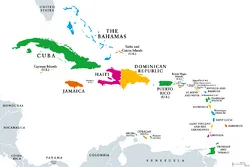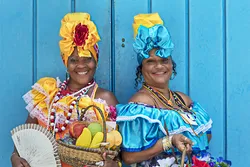See all articles relating to: The Caribbean

The Caribbean was initially populated by indigenous people, including the Arawaks and the Caribs, before the arrival of Europeans. Christopher Columbus, who arrived in 1492, marked the beginning of extensive European colonization, with Spain, France, Britain, and the Netherlands all establishing colonies. This period was marked by the brutal Atlantic slave trade, which brought millions of Africans to the region, transforming its cultural and demographic landscape. The colonial era was characterized by frequent wars, territorial disputes, and struggles for independence, with many Caribbean nations achieving independence in the 20th century. Important historical figures from the region include Toussaint Louverture, who led the Haitian Revolution resulting in the world's first Black-led republic and the first successful slave uprising; Marcus Garvey, a Jamaican political activist and important proponent of the Pan-Africanism movement; and Fidel Castro, the polarizing Cuban leader whose socialist revolution in 1959 had profound geopolitical consequences.
Research your ancestors on MyHeritage
The regions of The CaribbeanThe regions of The Caribbean
The Caribbean region is a large area consisting of the Caribbean Sea, its islands, and the surrounding coasts. The region is southeast of the Gulf of Mexico and the North American mainland, east of Central America, and north of South America:
- Greater Antilles: This region includes the larger islands of Cuba, Jamaica, Puerto Rico, Hispaniola (which is divided into Haiti and the Dominican Republic), and the Cayman Islands.
- Lesser Antilles: This region is further divided into the Windward Islands and the Leeward Islands. The Windward Islands include Grenada, St. Lucia, St. Vincent and the Grenadines, Dominica, and Martinique, among others. The Leeward Islands include the Virgin Islands, Anguilla, St. Kitts and Nevis, Antigua and Barbuda, Montserrat, and Guadeloupe, among others.
- Leeward Antilles: This region includes the islands off the northern coast of South America, such as Aruba, Bonaire, and Curaçao.
- Lucayan Archipelago: This region includes the Bahamas and the Turks and Caicos Islands.
- ABC Islands: This is a subregion of the Leeward Antilles and includes Aruba, Bonaire, and Curaçao.
- Netherland Antilles: This region includes the islands of Sint Maarten, Saba, and Sint Eustatius.
In addition to these island regions, the Caribbean also includes the coastal regions of countries like Colombia, Venezuela, Belize, Guyana, Suriname, and parts of Honduras, Nicaragua, Costa Rica, Panama, and Mexico that are on the Caribbean Sea.
The Caribbean historyThe Caribbean history
The Caribbean geographyThe Caribbean geography
Researching family history in The CaribbeanResearching family history in The Caribbean
See also:
- The Caribbean genealogy
- The Caribbean immigration
- The Caribbean emigration
- The Caribbean archives
- Vital records in The Caribbean
- Birth records in The Caribbean
- Death records in The Caribbean
- Marriage records in The Caribbean
- Census records in The Caribbean
- Civil registrations in The Caribbean
- Church records in The Caribbean
- Newspaper records in The Caribbean
- Military records in The Caribbean
Caribbean ethnicityCaribbean ethnicity

The Caribbean is a melting pot of ethnicities, each contributing to the region's rich cultural tapestry. The initial inhabitants were indigenous groups, predominantly the Arawaks and the Caribs. The arrival of Europeans during the Age of Discovery introduced Spanish, French, British, and Dutch ethnicities. The tragic history of the Atlantic slave trade brought a significant population of African descent. After the abolition of slavery, indentured laborers from India, China, and the Middle East were brought to work on plantations, further diversifying the region. Additionally, the region has seen immigration from the Middle East, particularly from Lebanon and Syria. Therefore, the ethnic fabric of the Caribbean is a mosaic of Indigenous, African, European, Indian, Chinese, and Middle Eastern influences.
See also:
The Caribbean surnamesThe Caribbean surnames

Caribbean surnames offer an intriguing window into the diverse and complex history of the region, and they can be a valuable resource when researching family history. The region's historical exposure to various colonial powers, the Atlantic slave trade, and immigration waves have resulted in a mixture of surnames of European, African, Indian, Chinese, and Middle Eastern origin. For instance, the surname "Ramirez" is common in the Caribbean and has Spanish and Hebrew origins. These surnames can reveal information about an individual's ethnic origins, socio-economic status, or even about specific historical events. Understanding the origins and historical transformations of these surnames can provide essential clues and help navigate the challenging journey of genealogical research in the Caribbean. For example, the surname "Maraj" is common in Trinidad and Tobago and is indicative of a person's Indian ancestry.
Examples of different Caribbean surnames:
See also:
